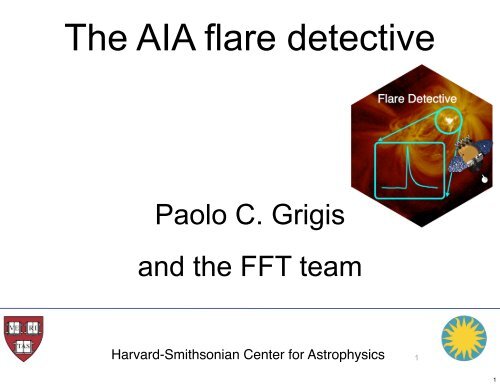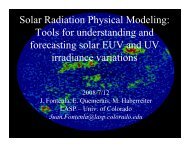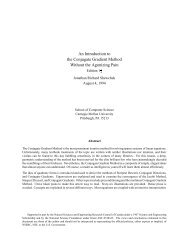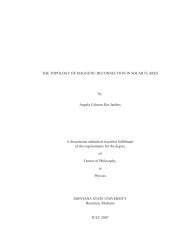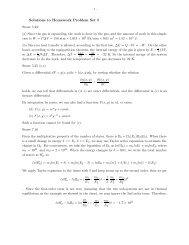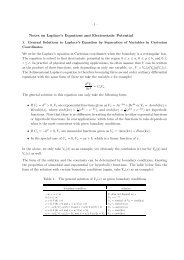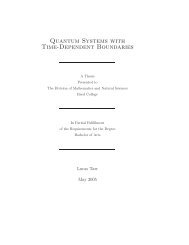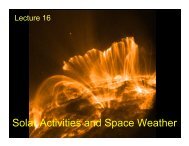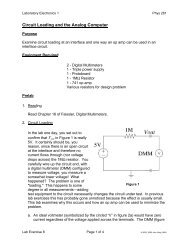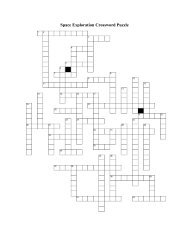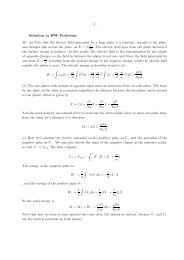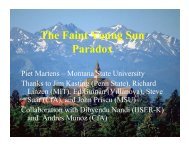The SDO Flare Detective - Solar Physics at MSU
The SDO Flare Detective - Solar Physics at MSU
The SDO Flare Detective - Solar Physics at MSU
Create successful ePaper yourself
Turn your PDF publications into a flip-book with our unique Google optimized e-Paper software.
<strong>The</strong> AIA flare detective<br />
Paolo C. Grigis<br />
and the FFT team<br />
Harvard-Smithsonian Center for Astrophysics<br />
1<br />
1
Overview<br />
• <strong>The</strong> Fe<strong>at</strong>ure Finding Team (FFT) is an intern<strong>at</strong>ional<br />
consortium with the task to produce a comprehensive<br />
autom<strong>at</strong>ed fe<strong>at</strong>ure and event recognition system for <strong>SDO</strong>.<br />
• It provides several different modules to look <strong>at</strong> different<br />
fe<strong>at</strong>ures and events.<br />
• <strong>The</strong> flare detective is the module with the<br />
detecting flares from AIA images<br />
task of<br />
Paolo Grigis<br />
Harvard-Smithsonian Center for Astrophysics<br />
2<br />
2
Inner working<br />
• FFT modules works a bit differently then the way one<br />
would build such a module if all d<strong>at</strong>a was available<br />
• <strong>The</strong> flare detective is fed one image <strong>at</strong> a time<br />
• <strong>The</strong>re is no options to retrieve th<strong>at</strong> image <strong>at</strong> a l<strong>at</strong>er time<br />
• All relevant inform<strong>at</strong>ion about past images is stored in an<br />
internal st<strong>at</strong>us of the module<br />
• One instance of the flare detective works with images<br />
from one AIA channel (independently from other<br />
instances of the module th<strong>at</strong> may be running on otehr<br />
channels)<br />
Paolo Grigis<br />
Harvard-Smithsonian Center for Astrophysics<br />
3<br />
3
New AIA<br />
image<br />
4<br />
4
New AIA<br />
image<br />
<strong>Flare</strong> <strong>Detective</strong><br />
processes image<br />
5<br />
5
New AIA<br />
image<br />
<strong>Flare</strong> <strong>Detective</strong><br />
processes image<br />
<strong>Flare</strong>s detected<br />
flares sent<br />
to HEK<br />
6<br />
6
New AIA<br />
image<br />
<strong>Flare</strong> <strong>Detective</strong><br />
processes image<br />
<strong>Flare</strong>s detected<br />
flares sent<br />
to HEK<br />
<strong>Flare</strong> <strong>Detective</strong><br />
upd<strong>at</strong>es its<br />
internal st<strong>at</strong>us<br />
7<br />
7
New AIA<br />
image<br />
<strong>Flare</strong> <strong>Detective</strong><br />
processes image<br />
<strong>Flare</strong>s detected<br />
flares sent<br />
to HEK<br />
<strong>Flare</strong> <strong>Detective</strong><br />
upd<strong>at</strong>es its<br />
internal st<strong>at</strong>us<br />
New AIA<br />
image<br />
<strong>Flare</strong> <strong>Detective</strong><br />
processes image<br />
8<br />
8
New AIA<br />
image<br />
<strong>Flare</strong> <strong>Detective</strong><br />
processes image<br />
<strong>Flare</strong>s detected<br />
flares sent<br />
to HEK<br />
<strong>Flare</strong> <strong>Detective</strong><br />
upd<strong>at</strong>es its<br />
internal st<strong>at</strong>us<br />
New AIA<br />
image<br />
<strong>Flare</strong> <strong>Detective</strong><br />
processes image<br />
<strong>Flare</strong>s detected<br />
flares sent<br />
to HEK<br />
9<br />
9
Inner working (2)<br />
• <strong>The</strong> large AIA images are segmented in a small number<br />
of macropixels<br />
• Lightcurves are computed for each macropixels<br />
• <strong>Flare</strong>s start times are determined when the deriv<strong>at</strong>ive of<br />
the lightcurve reaches a certain threshold<br />
• <strong>Flare</strong>s end times are determined when the flux is lower<br />
then a certain fraction of the peak flux<br />
Paolo Grigis<br />
Harvard-Smithsonian Center for Astrophysics<br />
10<br />
10
193A<br />
Paolo Grigis — Harvard-Smithsonian Center for Astrophysics — Hinode Meeting Palermo 2010<br />
11
Paolo Grigis — Harvard-Smithsonian Center for Astrophysics — Hinode Meeting Palermo 2010<br />
12
Rebinned AIA image with lightcurves<br />
Paolo Grigis<br />
Harvard-Smithsonian Center for Astrophysics 13<br />
13
14<br />
14
Lightcurve<br />
Deriv<strong>at</strong>ive<br />
15<br />
15
Lightcurve<br />
Deriv<strong>at</strong>ive<br />
Deriv<strong>at</strong>ive Threshold<br />
16<br />
16
Lightcurve<br />
<strong>Flare</strong> Start Detected<br />
Deriv<strong>at</strong>ive<br />
Deriv<strong>at</strong>ive Threshold<br />
17<br />
17
Lightcurve<br />
<strong>Flare</strong> Start Detected<br />
Deriv<strong>at</strong>ive<br />
Deriv<strong>at</strong>ive Threshold<br />
18<br />
18
Peak Strength<br />
Lightcurve<br />
<strong>Flare</strong> Start Detected<br />
Deriv<strong>at</strong>ive<br />
Deriv<strong>at</strong>ive Threshold<br />
19<br />
19
Peak Strength<br />
Lightcurve<br />
End fraction<br />
<strong>Flare</strong> Start Detected<br />
Deriv<strong>at</strong>ive<br />
Deriv<strong>at</strong>ive Threshold<br />
20<br />
20
Peak Strength<br />
Lightcurve<br />
End fraction<br />
<strong>Flare</strong> Start Detected<br />
<strong>Flare</strong> End Detected<br />
Deriv<strong>at</strong>ive<br />
Deriv<strong>at</strong>ive Threshold<br />
21<br />
21
challenges<br />
• <strong>Flare</strong>s in AIA look very different in different wavelength<br />
channels.<br />
• Lightcurves are simpler and more similar to the GOES<br />
lightcurves in the 94A and 131A channels (those are the<br />
hotter channels). <strong>The</strong> flare detection is most reliable in<br />
these channels.<br />
• Cooler channels show irregular spikes during the<br />
impulsive phase (presumably due to emission from the<br />
flare kernels) and secondary smoother peaks in the l<strong>at</strong>e<br />
phase (presumably due to cooling of hot flare m<strong>at</strong>erial in<br />
post-flare loops).<br />
•<br />
Paolo Grigis<br />
Harvard-Smithsonian Center for Astrophysics<br />
22<br />
22
23<br />
23
Performance<br />
• Code running on AIA images, stable<br />
• Events detected and exported to the Heliophysics<br />
Knowledgebase<br />
• Scientific valid<strong>at</strong>ion currently in progress<br />
• Thresholds are currently being optimized<br />
• Some channels deliver more events then others<br />
• 131A <strong>at</strong> the moment too sensitive<br />
Paolo Grigis<br />
Harvard-Smithsonian Center for Astrophysics<br />
24<br />
24
<strong>Flare</strong>s in 171A during the period 1-FEB-2011 1-MAY-2011<br />
25<br />
25
<strong>Flare</strong>s in 193A during the period 1-FEB-2011 1-MAY-2011<br />
26<br />
26
<strong>Flare</strong>s in 94A during the period 1-FEB-2011 1-MAY-2011<br />
27<br />
27
171A flares<br />
10.7 cm radio flux<br />
28<br />
28
D<strong>at</strong>a retrieval<br />
• Events detected can be retrieved by performing queries<br />
to the HEK d<strong>at</strong>abase<br />
• Example IDl code:<br />
IDL> query=ssw_her_make_query(StartTime,EndTime,/fl, $<br />
search ='frm_name=<strong>Flare</strong> <strong>Detective</strong> - Trigger Module')<br />
IDL> events=ssw_her_query(query,/struct4event)<br />
• <strong>Flare</strong> list in ASCII form<strong>at</strong> will also be delivered<br />
Paolo Grigis<br />
Harvard-Smithsonian Center for Astrophysics<br />
29<br />
29
Conclusion<br />
• <strong>The</strong> flare detective is running on AIA d<strong>at</strong>a and delivering<br />
preliminary events, however some degree of caution<br />
should be used <strong>at</strong> this point<br />
• Scientific valid<strong>at</strong>ion currently in progress<br />
• Look forward for the AIA flare list coming out soon!<br />
• Future development: more detailed characteriz<strong>at</strong>ion of the<br />
events detected<br />
Paolo Grigis<br />
Harvard-Smithsonian Center for Astrophysics<br />
30<br />
30


